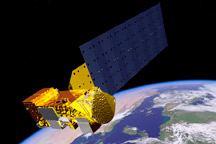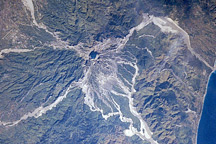Atmosphere
-
 A Delicate Balance: Signs of Change in the Tropics June 19, 2003
A Delicate Balance: Signs of Change in the Tropics June 19, 2003While NASA climate scientists were reviewing radiation data emanating from the tropics simply to test existing notions, they uncovered a phenomenon no one expected. They found that progressively more thermal radiation has been escaping the atmosphere above the tropics and progressively less sunlight has been reflecting off of the clouds.
-
 A New IDEA in Air Quality Monitoring August 17, 2004
A New IDEA in Air Quality Monitoring August 17, 2004Combining the assets of NASA and the EPA with NOAA's weather information is at the heart of a new NASA project called IDEA: Infusing Satellite Data into Environmental Air Quality Applications. IDEA will improve forecasters' ability to track regional pollution and make air quality forecasts.
-
 A View From Above (DAAC Study) September 24, 2001
A View From Above (DAAC Study) September 24, 2001International scientists with diverse backgrounds work together to better understand movement of carbon between the Earth's forests and atmosphere.
-
 A Violent Sun Affects the Earth's Ozone August 3, 2001
A Violent Sun Affects the Earth's Ozone August 3, 2001A new study confirms a long-held theory that large solar storms rain electrically charged particles down on Earth's atmosphere and deplete the upper-level ozone for weeks to months thereafter. New evidence from NASA and NOAA satellites is helping scientists better understand how man and nature both play a role in ozone loss.
-
 American Carbon: Vulcan Project Maps Nation's Fossil Fuel Emissions in Detail July 9, 2008
American Carbon: Vulcan Project Maps Nation's Fossil Fuel Emissions in Detail July 9, 2008The Vulcan Project maps when and where Americans burn fossil fuels.
-
 An Ocean Breeze: Mapping Brazil’s Offshore Wind Power Potential February 3, 2009
An Ocean Breeze: Mapping Brazil’s Offshore Wind Power Potential February 3, 2009Searching for alternative sources of energy for his country, one student turned to a NASA satellite to assess the feasibility of offshore wind power in Southeast Brazil.
-
 Aqua June 24, 2002
Aqua June 24, 2002Aqua carries six state-of-the-art instruments to observe the Earth's oceans, atmosphere, land, ice and snow covers, and vegetation, providing high measurement accuracy, spatial detail, and temporal frequency. This comprehensive approach enables scientists to study interactions among the many elements of the Earth system.
-
 Arbiters of Energy June 12, 2002
Arbiters of Energy June 12, 2002Clouds play a crucial role in regulating the balance of energy received by and emitted from the Earth, but scientists aren?t sure exactly what this role is.
-
 Arctic Reflection: Clouds Replace Snow and Ice as Solar Reflector January 31, 2007
Arctic Reflection: Clouds Replace Snow and Ice as Solar Reflector January 31, 2007Using satellite observations of sea ice and clouds, scientists discover that Earth’s poles are still effective reflectors for incoming sunlight.
-
 Ask-A-Scientist July 25, 2006
Ask-A-Scientist July 25, 2006Questions from visitors to the Earth Observatory and answers from scientists.
-
 Astronauts Photograph Mount Pinatubo June 14, 2001
Astronauts Photograph Mount Pinatubo June 14, 2001In early 1991, Mt. Pinatubo, a volcano north of Manila on the Philippine island of Luzon, had been dormant for more than 500 years. Few geologists would have guessed that it would produce one of the world's most explosive eruptions in the twentieth century.
-
 Aura: A Mission Dedicated to the Health of Earth's Atmosphere December 7, 2004
Aura: A Mission Dedicated to the Health of Earth's Atmosphere December 7, 2004On July 15, 2004 at 3:02 a.m., NASA launched the Aura satellite, the third flagship in a series of Earth-observing satellites designed to view Earth as a whole system, observe the net results of complex interactions within the climate system, and understand how the planet is changing in response to natural and human influences.
-
 Biomass Burning March 19, 2001
Biomass Burning March 19, 2001Biomass burning is the burning of living and dead vegetation, including both human-initiated burning for land clearing, and burning induced by lightning and other natural sources. Researchers with the Biomass Burning Project at NASA Langley Research Center are seeking to understand the impact that biomass burning has on the Earth's atmosphere and climate.
-
 Blanket of Clouds (DAAC Study) March 27, 2000
Blanket of Clouds (DAAC Study) March 27, 2000Recent studies indicate that clouds absorb significantly more shortwave radiation than previously thought.
-
 Blue Marble Next Generation October 13, 2005
Blue Marble Next Generation October 13, 200512 months of high-resolution global true color satellite imagery.
-
 CALIPSO: A Global Perspective of Clouds and Aerosols from Space July 26, 2002
CALIPSO: A Global Perspective of Clouds and Aerosols from Space July 26, 2002The Cloud-Aerosol Lidar and Infrared Pathfinder Satellite Observations (CALIPSO) satellite mission helps scientists answer significant questions about climatic processes by providing new information on clouds and aerosols.
-
 Carbon Conundrum (DAAC Study) May 22, 2000
Carbon Conundrum (DAAC Study) May 22, 2000Paradoxically, an increase in global temperature may both increase and decrease atmospheric carbon dioxide. The key is timing.
-
 Changing Global Cloudiness May 13, 1999
Changing Global Cloudiness May 13, 1999Clouds are one of the most obvious and influential features of Earth’s climate system. They are also one of its most variable components. The natural diversity and variability of clouds has intrigued and challenged researchers for centuries.
-
 Changing Our Weather One Smokestack at a Time August 7, 2000
Changing Our Weather One Smokestack at a Time August 7, 2000Daniel Rosenfeld and a team of scientists from the Hebrew University of Israel recently discovered that aerosol particles from factories and power plants increase the number of droplets in clouds they pollute. In doing so, the pollutants create brighter clouds that retain their water and do not produce rain.
-
 Chemistry in the Sunlight January 28, 2003
Chemistry in the Sunlight January 28, 2003Ozone has proven to be among the most difficult air pollutants to control. To control ozone requires understanding its complex chemistry and how the chemical travels from one locality to another. Chemistry in the Sunlight explains basic aspects of ozone formation and provides a sample set of chemical reactions involved in ozone production.
-
 Cheyenne and Catarina: Breaking Records for Sailing and Storms April 26, 2005
Cheyenne and Catarina: Breaking Records for Sailing and Storms April 26, 2005When the crew of the Cheyenne set out to break the round-the-world sailing record in March 2004, they would never have guessed what an unusual storm they would meet along the way.
-
 Cities at Night: The View from Space April 22, 2008
Cities at Night: The View from Space April 22, 2008Astronauts onboard the International Space Station capture nighttime photographs of city lights, spectacular evidence of humanity's existence, our distribution, and our ability to change our environment.
-
 Clouds & Radiation Fact Sheet March 1, 1999
Clouds & Radiation Fact Sheet March 1, 1999The study of clouds, where they occur, and their characteristics, plays a key role in the understanding of climate change. Low, thick clouds reflect solar radiation and cool the Earth's surface. High, thin clouds transmit incoming solar radiation and also trap some of the outgoing infrared radiation emitted by the Earth, warming the surface.
-
 Clouds are Cooler than Smoke July 27, 2004
Clouds are Cooler than Smoke July 27, 2004New NASA research shows that smoke from fires in the Amazon Basin inhibits clouds and exerts a warming influence on Earth's surface.
-
 Clouds in a Clear Sky (DAAC Study) September 24, 1999
Clouds in a Clear Sky (DAAC Study) September 24, 1999Scientists have detected a nearly invisible cloud layer that may explain dryness in the stratosphere.
-
 Clouds in the Balance (DAAC Study) October 11, 2001
Clouds in the Balance (DAAC Study) October 11, 2001In 1998, atmospheric scientists discovered a significant change in cloud vertical structure triggered by the strongest El Niño on record.
-
 Cloudy with a Chance of Drizzle August 9, 2005
Cloudy with a Chance of Drizzle August 9, 2005By analyzing data from the MISR instrument, scientists discover that a unique type of cloud formation is much more prevalent than previously believed.
-
 Critical Chemistry (DAAC Study) February 14, 2000
Critical Chemistry (DAAC Study) February 14, 2000Researchers map ozone's global distribution using data from the Global Tropospheric Experiment.